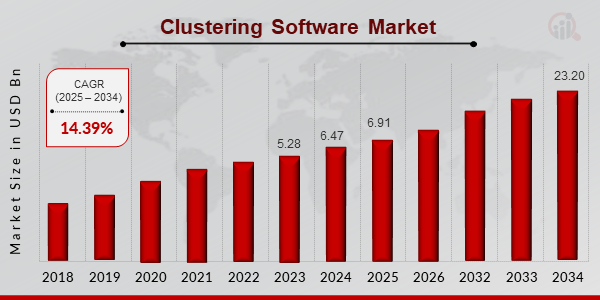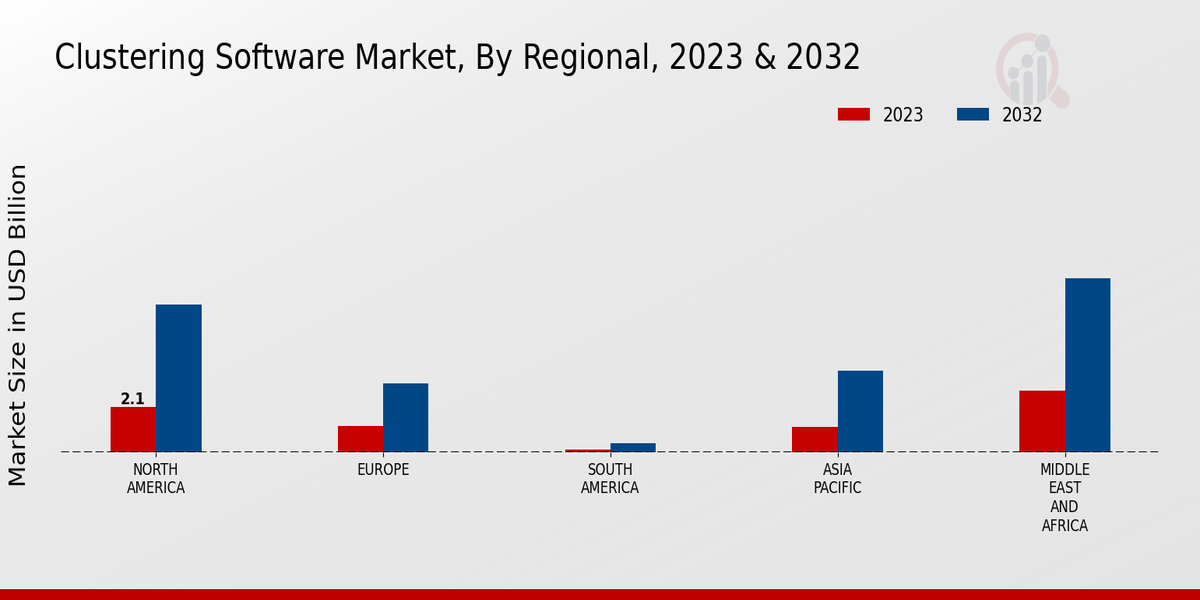Clustering Software Market Overview
Clustering Software Market is projected to grow from USD 6.91 Billion in 2025 to USD 23.20 Billion by 2034, exhibiting a compound annual growth rate (CAGR) of 14.39% during the forecast period (2025 - 2034). Additionally, the market size for Clustering Software Market was valued at USD 6.47 billion in 2024.
Key Clustering Software Market Trends Highlighted
Artificial Intelligence-powered data analytics and machine learning techniques are gaining prominence in the Clustering Software Market, leading to the development of advanced clustering algorithms. Trends in recent times reveal a growing demand for automated clustering solutions that streamline data analysis processes. Organizations are seeking software that can effectively identify patterns, group similar data points, and improve decision-making based on data insights. Additionally, the integration of cloud computing platforms and the increasing availability of open-source clustering software are fostering market growth.
Figure 1: Clustering Software Market Size, 2025-2034 (USD Billion)

Source: Primary Research, Secondary Research, MRFR Database and Analyst Review
Clustering Software Market Drivers
Growing Adoption of Artificial Intelligence (AI) and Machine Learning (ML)
The market for clustering software has seen a significant transformation due to the introduction of AI and ML, as have other industries. Data analysis and trend discovery can be automated with clustering software that uses AI and ML algorithms. This helps companies make better decisions, obtain deeper insights into their data, and increase productivity. In the upcoming years, the worldwide clustering software market is anticipated to increase significantly due to the increasing implementation of AI and ML technologies.
Increasing Demand for Data-Driven Decision Making
Businesses are depending more and more on data to make decisions in today's data-driven business climate. In this sense, clustering software is essential because it enables companies to find hidden patterns and connections in their data. They are able to better focus their marketing initiatives, segment their consumer base, and streamline their business processes thanks to data-driven insights. The Clustering Software Market industry is predicted to increase as a result of the increasing need for data-driven decision-making.
Rising Adoption of Cloud-Based Clustering Solutions
Cloud-based solutions are becoming more and more popular in many industries, and the market for clustering software is no exception. Solutions for cloud-based clustering have many benefits, including cost-effectiveness, scalability, and adaptability. Clustering software is available to businesses on a subscription basis, negating the need for initial capital outlays. Furthermore, cloud-based solutions spare organizations the headache of maintaining IT infrastructure by giving them access to the newest features and software updates. The Clustering Software Market industry is predicted to expand as a result of the growing use of cloud-based clustering solutions.
Clustering Software Market Segment Insights
Clustering Software Market Solution Type Insights
The growing demand for data analytics, machine learning, and artificial intelligence is driving the market growth. Solution Type is one of the key segments of the Clustering Software Market. Self-service clustering, managed clustering, and hybrid clustering are the three main types of solutions available in the market. Self-service clustering is a solution that enables users to perform clustering tasks without requiring the assistance of an expert. This type of solution is ideal for small and medium-sized businesses that have limited resources. Managed clustering is a solution that provides users with access to a team of experts who can help them with clustering tasks.This type of solution is ideal for large enterprises that have complex data requirements. Hybrid clustering is a solution that combines the features of self-service clustering and managed clustering. This type of solution is ideal for organizations that have a mix of complex and simple data requirements. The self-service clustering segment held the largest share of the Clustering Software Market revenue in 2023. This segment is expected to grow at a CAGR of 14.5% over the forecast period. The growth of this segment is attributed to the increasing adoption of self-service clustering solutions by small and medium-sized businesses.The managed clustering segment held the second largest share of the Clustering Software Market revenue in 2023. This segment is expected to grow at a CAGR of 14.2% over the forecast period. The growth of this segment is attributed to the increasing adoption of managed clustering solutions by large enterprises. The hybrid clustering segment held the smallest share of the Clustering Software Market revenue in 2023. However, this segment is expected to grow at the fastest rate over the forecast period. The growth of this segment is attributed to the increasing adoption of hybrid clustering solutions by organizations that have a mix of complex and simple data requirements.

Source: Primary Research, Secondary Research, MRFR Database and Analyst Review
Clustering Software Market Deployment Type Insights
The deployment type segment is further bifurcated into on-premises and cloud-based. In 2023, the on-premises segment accounted for a larger market share and is expected to maintain its dominance throughout the forecast period. However, the cloud-based segment is expected to grow at a faster CAGR during the forecast period due to its scalability, flexibility, and cost-effectiveness. The increasing adoption of cloud-based solutions by enterprises is a major factor driving the growth of the cloud-based clustering software market. In 2023, the cloud-based segment's revenue was valued at around 1.23 Billion USD, and it is projected to reach 5.6 Billion USD by 2032, exhibiting a CAGR of 18.7%.
Clustering Software Market Industry Vertical Insights
The Industry Vertical segment is a crucial aspect of the Clustering Software Market, influencing its growth and revenue generation. In 2023, the Retail industry held a significant market share, driven by the need for efficient customer segmentation and personalized marketing campaigns. The Banking, Financial Services & Insurance (BFSI) sector is also a major contributor, utilizing clustering software for fraud detection, risk management, and customer profiling. The Healthcare & Life Sciences industry leverages clustering algorithms for disease diagnosis, drug discovery, and patient stratification.Manufacturing companies employ clustering techniques for product segmentation, quality control, and predictive maintenance. The IT & Telecommunications industry utilizes clustering software for network optimization, customer churn prediction, and service personalization. Other industries, such as transportation and logistics, government, and education, also contribute to the growth of the Clustering Software Market. These industry-specific applications drive market growth and provide vendors with opportunities to develop tailored solutions that meet the unique requirements of each sector.
Clustering Software Market Regional Insights
The regional segmentation of the Clustering Software Market offers valuable insights into market dynamics and growth potential. North America held the largest market share in 2023, driven by the presence of major technology hubs and a high adoption rate of AI and data analytics. Europe is another significant region, with a strong focus on healthcare and manufacturing sectors. The Asia Pacific (APAC) region is poised for rapid growth, owing to increasing investments in digital transformation and a growing demand for data-driven solutions. South America and the Middle East Africa (MEA) regions present emerging opportunities for market growth, supported by government initiatives to promote digitalization and data management.

Source: Primary Research, Secondary Research, MRFR Database and Analyst Review
Clustering Software Market Key Players And Competitive Insights
Major players in the Clustering Software Market are expanding their global reach through strategic partnerships and collaborations to improve their product offerings and gain competitive advantages. The Clustering Software Market industry is witnessing increasing competition as leading Clustering Software Market players invest in research and development to introduce innovative solutions and enhance their market presence. The competitive landscape is expected to remain dynamic due to the entry of new players and the expansion of existing players into new regions.A leading player in the Clustering Software Market is SAS Institute Inc., which offers a comprehensive suite of clustering software solutions for various industries. SAS Institute focuses on providing advanced analytics capabilities, including machine learning and artificial intelligence, to help organizations derive insights from complex data. The company has a strong track record of innovation and has been recognized for its contributions to the field of data management and analytics.Another key competitor in the Clustering Software Market is IBM Corporation. IBM offers a range of clustering software solutions, including its popular SPSS Modeler and Watson Studio products. The company leverages its expertise in data science and artificial intelligence to provide organizations with powerful tools for data analysis and predictive modeling. IBM has a global presence and serves a wide range of industries, including healthcare, financial services, and manufacturing.
Key Companies in the Clustering Software Market Include:
Clustering Software Market Industry Developments
The Clustering Software Market is projected to reach USD 15.5 billion by 2032, exhibiting a CAGR of 14.39% from 2024 to 2032. The rising adoption of artificial intelligence (AI) and machine learning (ML) technologies, increasing demand for data analytics, and growing need for customer segmentation are key factors driving market growth. Recent news developments include the launch of new clustering software solutions by major vendors such as IBM, SAP, and Oracle. Additionally, strategic partnerships and acquisitions are shaping the market landscape. For instance, in 2023, Alteryx acquired ClearStory Data to enhance its data clustering capabilities. These developments indicate the growing importance of clustering software in various industries, including healthcare, retail, and manufacturing.
Clustering Software Market Segmentation Insights
-
Clustering Software Market Solution Type Outlook
-
Self-Service Clustering
-
Managed Clustering
-
Hybrid Clustering
-
Clustering Software Market Deployment Type Outlook
-
Clustering Software Market Industry Vertical Outlook
-
Clustering Software Market Regional Outlook
-
North America
-
Europe
-
South America
-
Asia Pacific
-
Middle East and Africa
| Report Attribute/Metric |
Details |
|
Market Size 2024
|
6.47 (USD Billion)
|
|
Market Size 2025
|
6.91 (USD Billion)
|
|
Market Size 2034
|
23.20 (USD Billion)
|
|
Compound Annual Growth Rate (CAGR)
|
14.39% (2025 - 2034)
|
|
Report Coverage
|
Revenue Forecast, Competitive Landscape, Growth Factors, and Trends
|
|
Base Year
|
2024
|
|
Market Forecast Period
|
2025 - 2034
|
|
Historical Data
|
2019 - 2023
|
|
Market Forecast Units
|
USD Billion
|
| Key Companies Profiled |
Informatica Corporation, Splunk Inc., Oracle Corporation, Google LLC, SAP SE, SAS Institute Inc., Micro Focus International plc, Alteryx Inc., Tibco Software Inc., RapidMiner Inc., Amazon Web Services Inc., Microsoft Corporation, IBM Corporation, Qubole Inc., Teradata Corporation |
| Segments Covered |
Solution Type, Deployment Type, Industry Vertical, Regional |
| Key Market Opportunities |
Growth in big data analytics Increasing demand for customer segmentation Rise in cloud computing Advancements in artificial intelligence Adoption in healthcare sector |
| Key Market Dynamics |
Rising adoption of cloudbased analytics Growing demand for personalized recommendations Advances in machine learning and AI Increasing adoption of data science techniques Growing focus on data security and compliance |
| Countries Covered |
North America, Europe, APAC, South America, MEA |
Frequently Asked Questions (FAQ) :
The Clustering Software Market is expected to reach USD 6.91 billion in 2025 and USD 23.20 billion by 2034, exhibiting a CAGR of 14.39% during the forecast period.
North America is expected to hold the largest market share, followed by Europe, Asia-Pacific, and the Rest of the World.
Clustering Software finds applications in various industries, including healthcare, retail, manufacturing, and financial services.
Major players operating in the Clustering Software Market include IBM, SAS Institute, Oracle, Microsoft, and SAP.
Increasing demand for data analytics, rising adoption of cloud computing, and growing need for customer segmentation are driving the growth of the Clustering Software Market.
Data security concerns, lack of skilled professionals, and high implementation costs are some of the challenges faced by the Clustering Software Market.
Growing adoption of artificial intelligence (AI) and machine learning (ML), increasing demand for real-time data analysis, and rising focus on predictive analytics are some of the expected trends in the Clustering Software Market.
The Clustering Software Market is expected to grow at a CAGR of 14.39% from 2024 to 2032.

















